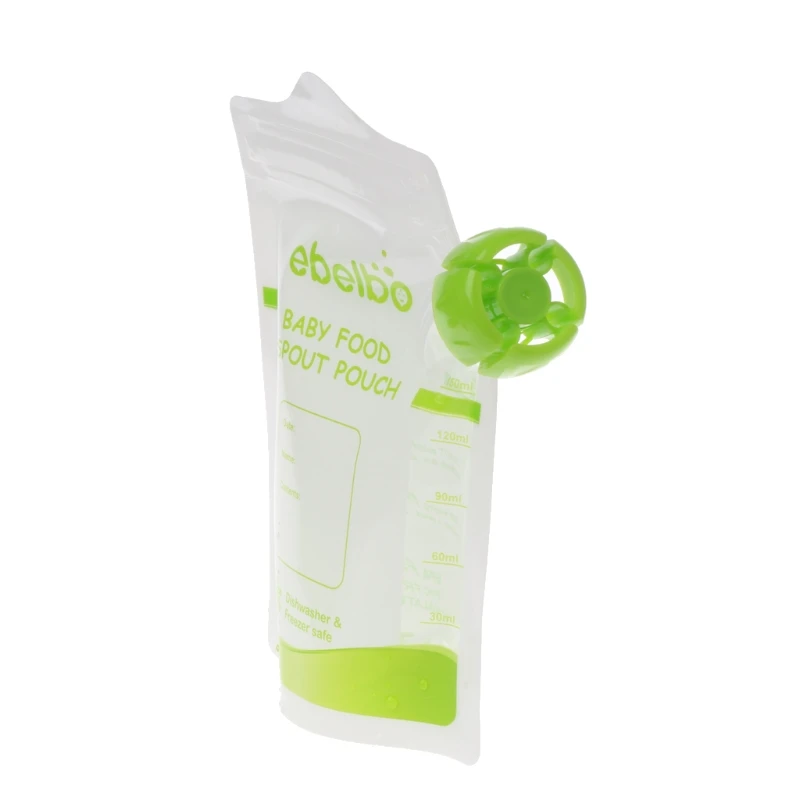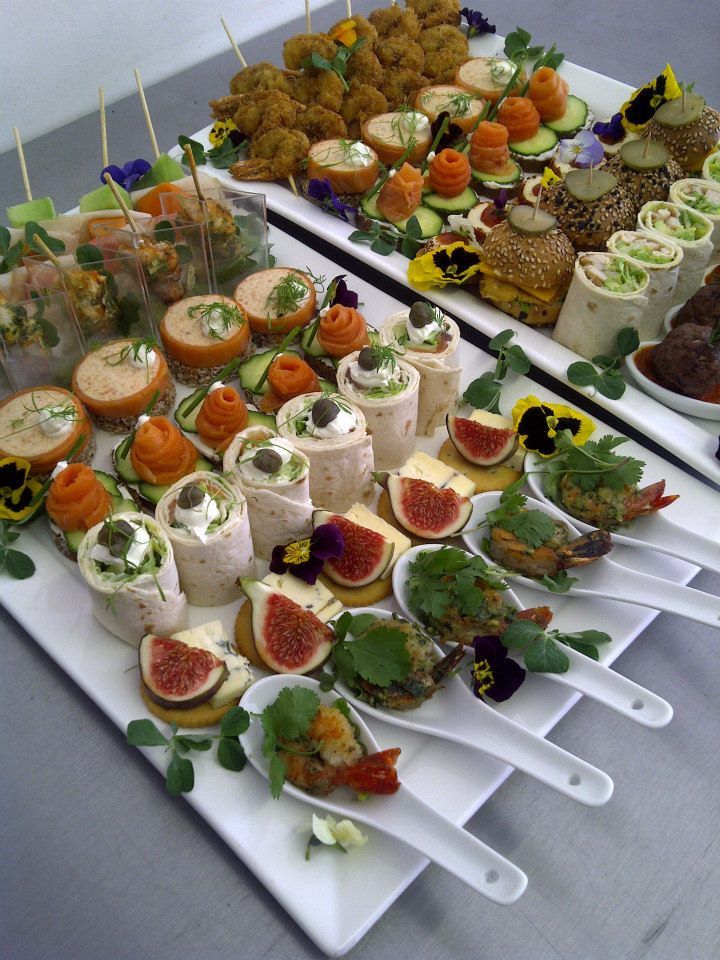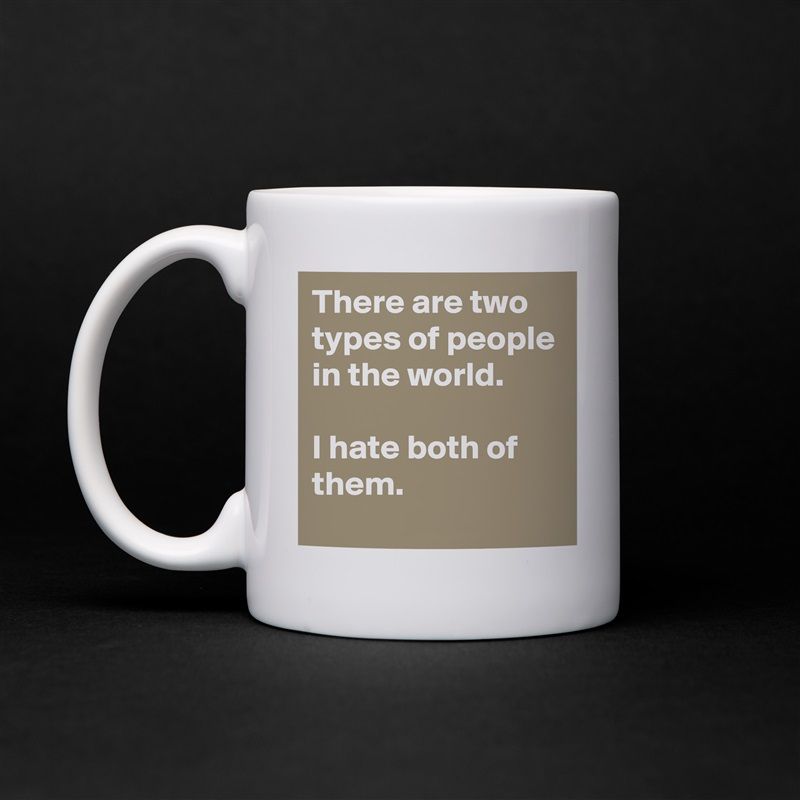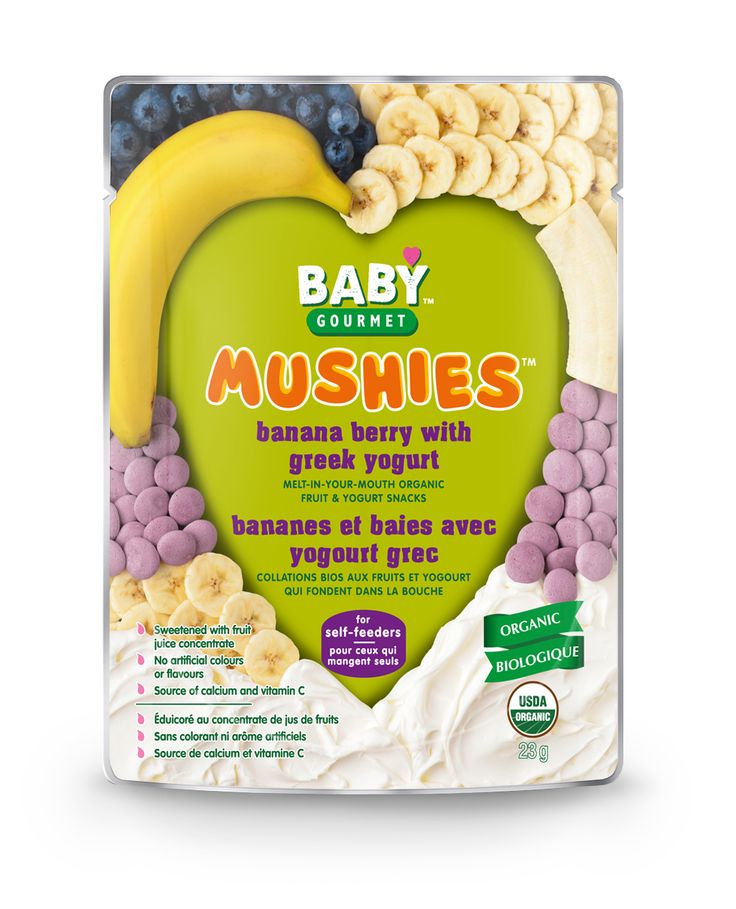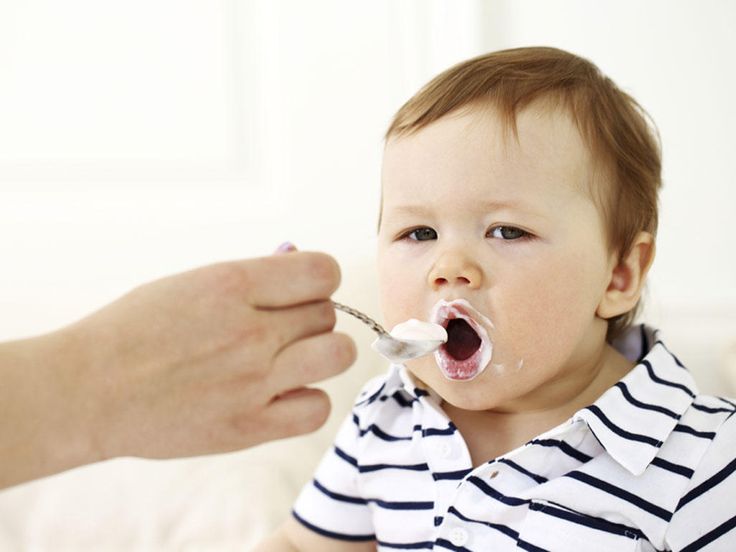Baby feeding pouch
Baby Food Pouches: Pros, Cons and Practical Advice
Should you give your child a baby food pouch?
It hasn’t taken long for baby food pouches to show up in grocery stores and superstores everywhere. You can even find them at some Starbucks!
In fact, it’s safe to say they’ve become part of the nutrition mainstream for babies and toddlers.
Baby food pouches may provide a good source of fruits and/or veggies, with many brands boasting no added sugars, juices, salt or artificial colors and use of all organic ingredients.
Some companies claim their products are cooked at lower temperatures than jarred baby food, increasing their nutrient content.
While the possibilities are endless with these convenient creations, others advise caution when using them.
In this article, you’ll learn:
- The pros and cons of using baby food pouches
- Why it’s important to connect through feeding
- 5 pointers for effective use of food pouches
The Pros of Baby Food Pouches
Pouches are easily portable and re-sealable for handy feeding at home or on the go. They don’t get crushed like some whole fruits and vegetables or break like glass jars.
Storage is a snap; you can refrigerate or freeze any partially used containers. They can be eaten cold, at room temperature, or heated up in warm water.
They make fruits and vegetables more accessible to toddlers when fresh options are not available or when time is limited.
It’s easy to complement your own cooked meals or restaurant fare with these blends to boost your child’s fruit and vegetable content.
Concerns about Food Pouches
Even though I think they are a wonderful option overall, I do have a few concerns about how these products are used. Like all baby food, the single-ingredient fruits or fruit and vegetable blends should be introduced around 6 months, when your baby shows developmental signs of readiness.
For infants, spoon feeding utilizes mouth muscles necessary for proper speech. Additionally, toddlers can learn how to use a spoon to build fine motor skills.
I recommend using a spoon when feeding these purees.
It is ok for toddlers to “suck” on these pouches occasionally.
However, make sure your tot has started spoon-feeding themselves, eating finger foods, and drinking from a cup with minimal spilling before giving them a pouch to “suck on.”
Don’t depend on pouches as a sole source of your child’s fruits and veggies, you want him or her to recognize and accept whole fruits and vegetables, too!
Get the Food & Nutrients for Baby’s Brain!
Keep Your Baby’s Nutrition in Mind
As baby food pouches become more popular, however, parents want to make sure they fit them into the overall goals for their child’s nutritional needs and developmental progress.
Starting solids is a very important phase and there are a few overarching goals to keep in mind:
- Support your baby’s growth and development by supplying the nutrition he needs, especially for critical nutrients like iron, DHA and vitamin D.

- Advance your little one along with feeding skills. By a year of age, your baby should be self-feeding with utensils (and his hands), drinking out of a cup and eating a wide variety of flavors and textures.
- Setting up healthy eating habits.
Feeding is as Important as Food
With the fast-paced world we live in, it’s easy to put feeding on the back burner and give your youngster foods they can eat without your help.
Remember, feeding is a chance to connect and enhance attachment. When your child eats in the back seat while you drive, you miss out on an opportunity to connect.
A positive feeding relationship in infancy sets the stage for future healthy eating in toddlerhood, childhood and the teen years.
5 Pointers for Using Baby Food Pouches
I’ve got a few pointers for using baby food pouches so your baby becomes the healthy, self-feeder he was meant to be!
1. Incorporate the Spoon
The original intent when baby food pouches came out on the market was to use them with a spoon.
Parents could squeeze a bit of baby food onto the spoon and feed it to their infant.
Today, the spoon is skipped and sucking from the pouch is the norm. This misses the opportunity to teach baby how to eat off a spoon and use his mouth muscles to manage, propel and chew food.
All babies need diversified texture so they learn to chew, self-feed and advance their feeding skills.
Babies who do not advance to more textured food by 9 months of age have been shown to have a greater likelihood of having feeding problems later.
Using a pouch won’t hurt your baby if you keep moving forward with feeding skills, such as introducing finger foods, offering the spoon, and encouraging self-feeding.
2. Mix in More Texture
Add textured foods such as chopped and cooked veggies, rice, noodles or shredded meats in a bowl with baby food from pouches to increase the texture experience.
These varied textures will stimulate your baby’s sensory system and train his mouth muscles to handle a wide range of food textures.
3. Monitor Baby when Eating a Baby Food Pouch
No matter what, when, or how you feed your baby, he or she needs to be monitored to watch for choking and to continue to enhance the parent-child connection and bond.
4. Start Finger Foods Between Six and Eight Months
Between six and eight months, babies develop their hand grasp and can hold a finger-shaped, or long, thin rectangle of soft food, such as buttered toast, soft cooked vegetables like sweet potato, or ripe fruit like banana or avocado.
By eight months, the pincer grasp emerges, and your baby can pick up small bits of food with his thumb and forefinger.
At this stage, introduce finer foods like strips and small cubes of soft food to your baby’s meal routine.
Use this opportunity to introduce singular veggies and fruits so your baby can appreciate the flavor and texture of these foods.
5. Always Sit to Eat
This is good advice for any child at any age (even adults), but especially for the new eater who is learning to handle food.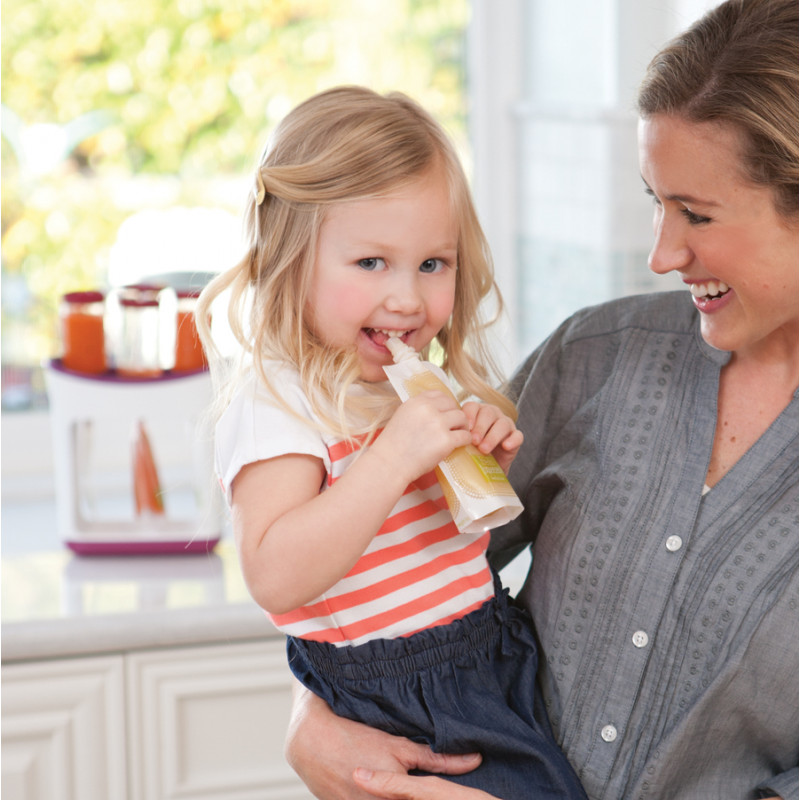
Sitting for meals and snacks helps children pay attention to their food and eating, learn to eat mindfully, and stop eating when full.
Your job is to provide quality nutrition and establish a good eating environment. Use developmentally appropriate feeding utensils and food textures to foster lifelong eating habits.
Need More Help with Feeding Baby?
Check out our nutrition booklets, workshops, and courses and my book, The Smart Mom’s Guide to Starting Solids.
You may also enjoy reading:
- Is Rice Cereal for Babies Safe?
- Toxins in Baby Food: What You Need to Know
This article was updated on January 26, 2020.
The Best Baby Food Pouches: 2022 Guide
By Anjali Shah on · Last Updated on
This post may contain affiliate links. As an Amazon Associate, I earn from qualifying purchases. Please read my disclosure.
As an Amazon Associate, I earn from qualifying purchases. Please read my disclosure.
This is your guide to the healthiest and best baby food pouches on the market today! Learn what to avoid, what to buy, and what to look for on the label!
When your little one transitions to solids, a common question is: should I buy pre-made baby food pouches or make baby food at home? While it doesn’t necessarily have to be an either-or, many of you know that I’m a huge fan of homemade baby food because it’s so easy and you can control all of the ingredients your little one is getting. I shared all of the recipes I used for Layla and Ayan in my baby food cookbook and put many on my blog here!
But there are those times when you’re on the go, or pressed for time, and you don’t have any homemade baby food on hand. Which is when baby food pouches can be a quick and convenient meal for your little one! But there are SO many baby food pouches out there, and not all of them are healthy.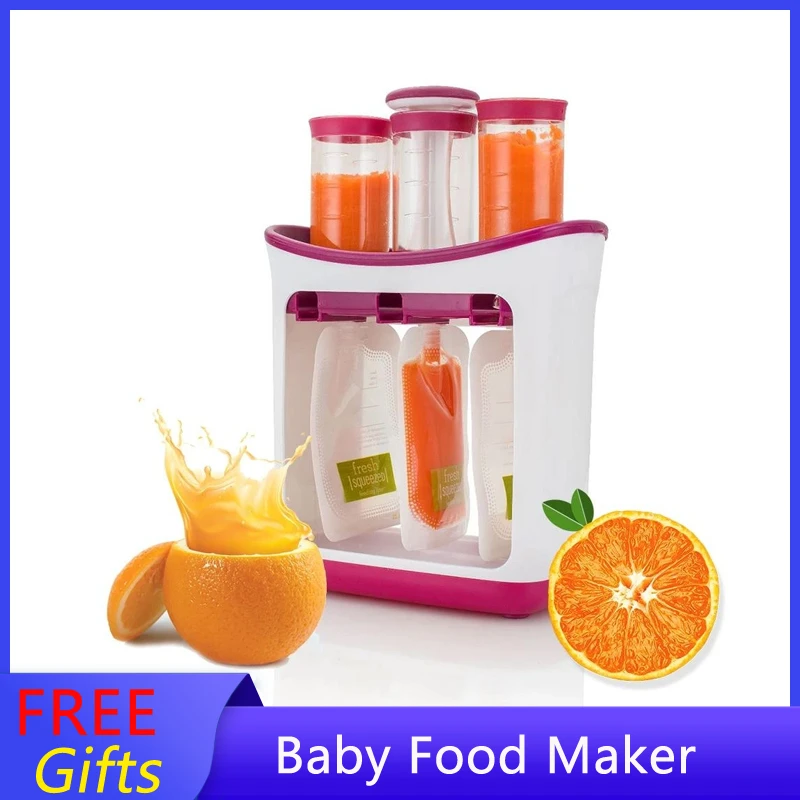 Many are filled with processed ingredients and added sugars. This can set your baby up to only appreciate sweet foods and reject vegetables as they get older. So what should you buy? And what should you avoid?
Many are filled with processed ingredients and added sugars. This can set your baby up to only appreciate sweet foods and reject vegetables as they get older. So what should you buy? And what should you avoid?
This is your guide to the best baby food pouches available today!
Can Some Baby Food Pouches Really Be That Unhealthy?
The food industry knows that babies shouldn’t be having added sugars when they first start solids, right?
Wrong.
As you have probably heard when it comes to buying pre-packaged food, what’s on the front is often misleading. This is also true when it comes to baby food pouches. The front may say spinach and kale, but when you turn it over you’ll find less expensive fillers such as fruit purees, or even fruit juices like apple juice concentrate. Sometimes in a “spinach” pouch the first 3 ingredients are fruits! That’s because, while there may be spinach, the manufacturer is not required to list the percentage of ingredients on the label.
This basically means that your baby is only getting a sweet taste when eating that pouch and isn’t getting exposed to the actual taste of a vegetable. And in those early months of developing tastebuds, getting exposure to all kinds of flavors and tastes is essential to having a baby who doesn’t become a picky eater (who rejects veggies) later on!
Why Is It So Confusing To Find The Best Baby Food Pouches For Your Child?
Ingredient labels are confusing, packaging is misleading. I remember when I first gave Layla a baby food pouch and she devoured it. It was a pouch that said “organic super greens” on it. And I remember thinking: “Yeah! She loves greens!” When I turned it over, the ingredients were: bananas, pear, apple, spinach. What??
It has always really bothered me that most baby food pouches (even the ones promoting veggies) contain fruit. Like why add bananas or pears to a carrot & sweet potato pouch? Carrots and sweet potatoes are already naturally sweet – there is no need for fruit purees to make it even sweeter! Since breast milk is naturally sweet, it’s so important that babies learn the other tastes: bitter, sour, pungent, etc.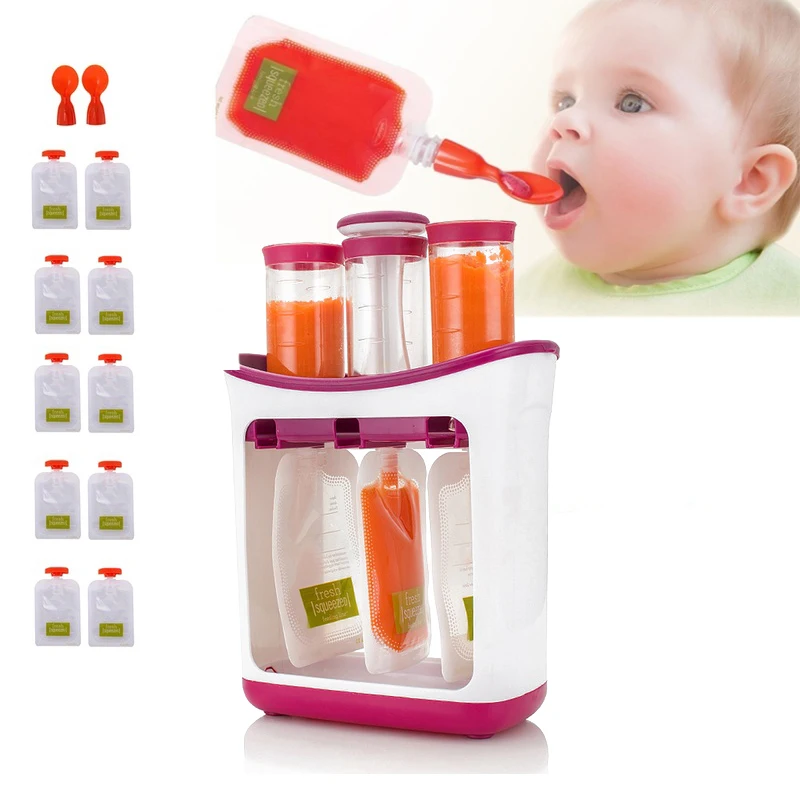 when they start solids. All the fruit purees are essentially taking over your baby’s taste buds, making them think that if food isn’t sweet it’s not worth eating.
when they start solids. All the fruit purees are essentially taking over your baby’s taste buds, making them think that if food isn’t sweet it’s not worth eating.
On top of that, many pouches that are fruit-forward and look healthy actually have a ton of unnecessary processed ingredients added. Take a look at Gerber’s Fruit & Yogurt Strawberry Banana Pouch.
Sugar, Carrot Juice Concentrate, Natural Flavor, Gelatin, Two different types of coloring…
These are all major red-flag ingredients in baby food. What in the world is gelatin doing in a pouch that looks vegetarian-friendly? And for a pouch that is supposed to have apples and strawberries (both of which are rich in fiber), there is less than 1g fiber in the entire pouch because of all of the fillers added. AND this pouch has 14g sugar. That’s as much as 1.5 Fun Sized Milky Way bars, or 1/3 of a can of Coke.
That’s why reading labels is so important to finding healthy, packaged baby food! So how do you find those pouches? Skip to the end of this post for my list of the healthiest baby food pouches! But first…
Top 5 Tips To Find The Best Baby Food Pouches
- Look at the sugar content: Stick to pouches with less than 8g of sugar, but ideally you’ll want to find pouches between 4-6g of sugar.
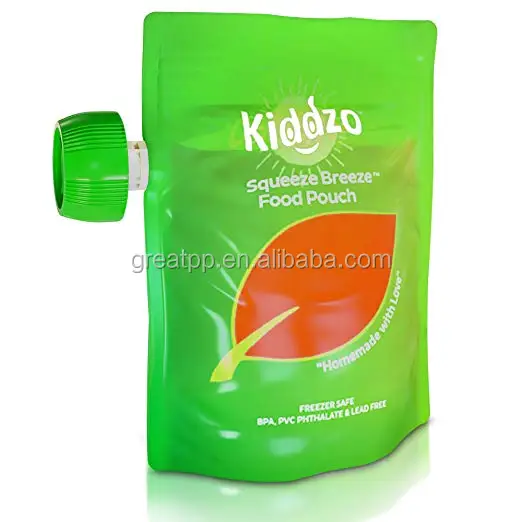 For example, if you look at the front of Ella’s Organic Apples, Green Beans, Raisins pouch, you might think, “green beans are in here, this is great!” But the pouch actually has 13g of sugar from the apples and raisins, while the green beans are a very small addition. 13g sugar is equal to a fun sized milky way bar.
For example, if you look at the front of Ella’s Organic Apples, Green Beans, Raisins pouch, you might think, “green beans are in here, this is great!” But the pouch actually has 13g of sugar from the apples and raisins, while the green beans are a very small addition. 13g sugar is equal to a fun sized milky way bar. - Look to see if the ingredient listed on the front of the package is the first ingredient listed on the back. If you’re buying “spinach and apples,” it’s likely that apples are the dominant flavor. Some companies are more transparent than others on the percentage or amount of each ingredient in the pouch.
- Stick to pouches that ONLY have vegetables. These are harder to find, but they do exist. And they actually taste like vegetables! If you do buy one with veggies & fruits, make sure there is <8g sugar, that vegetables are first, and fruits are last on the ingredients list. Beware of labels that make it seem like the pouch only has veggies: there are some deceptive pouches such as Veggie Blends, and Plum Organics Mighty Veggie pouches.
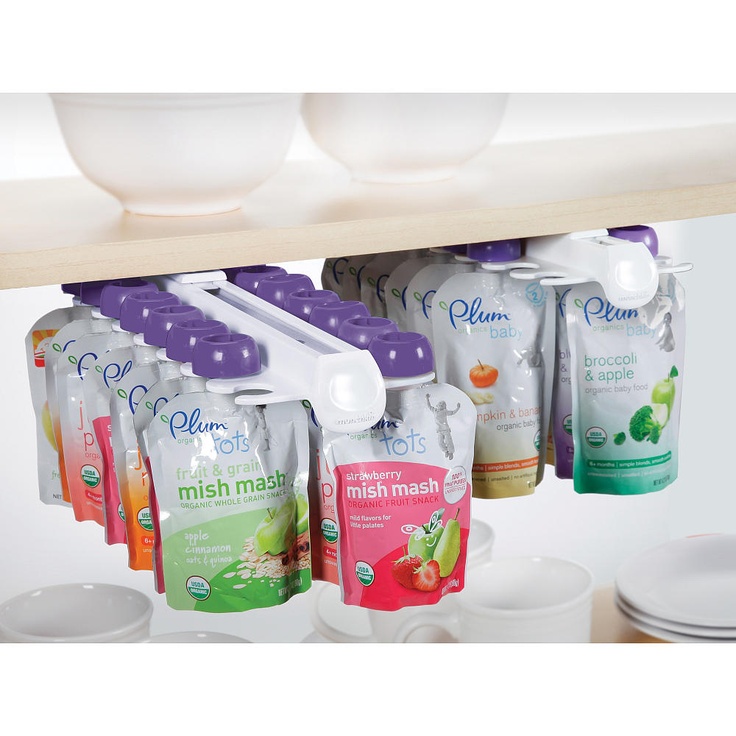 These veggie blends also contain fruit, and often has as much or sometimes more sugar than those labeled as fruit blends.
These veggie blends also contain fruit, and often has as much or sometimes more sugar than those labeled as fruit blends. - Fiber matters. A good sign that a pouch is either mostly water or fillers is when the fiber content is 1g or less. Aim for pouches with 2g fiber or more.
- Avoid ingredients likely to be contaminated with heavy metals. Pouches that have apples, pears, carrots, sweet potatoes, and rice are particularly at risk. (For more details: A study done by the Clean Label Project in 2017 found that 65% of baby food products had detectable levels of arsenic, 36% detectable levels of lead, and 58% contained detectable levels of cadmium. A more recent study done by Consumer Reports in August of 2018 found that out of 50 nationally distributed baby food products, every single one of them had trace amounts of at least one of the heave metals which included arsenic, lead, or cadmium. Two-thirds of those tested had worrisome amounts of heavy metals, and 15 of the foods could pose potential health risk.
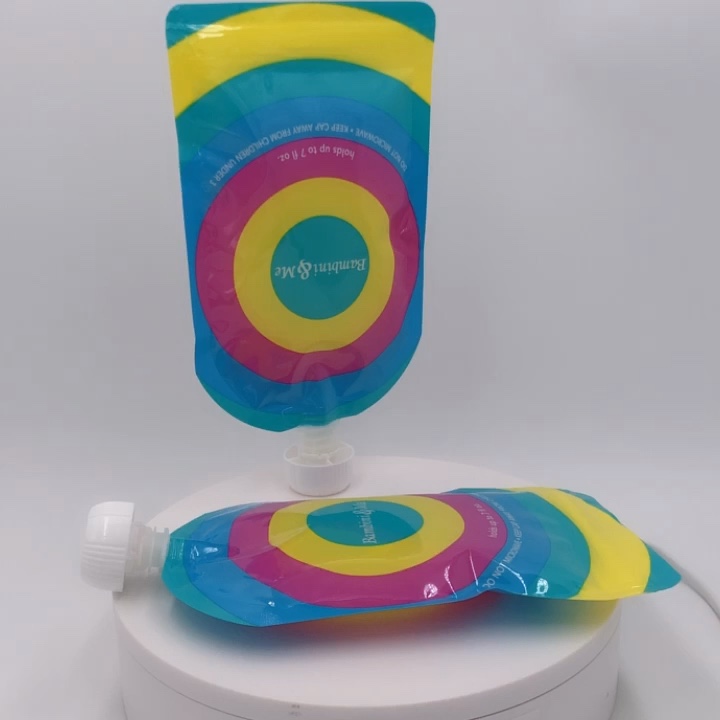 The pouches that included rice and/or sweet potato were more likely to have higher amounts of heavy metal, and organic foods were just as likely to contain heavy metals as their non-organic counterparts.)
The pouches that included rice and/or sweet potato were more likely to have higher amounts of heavy metal, and organic foods were just as likely to contain heavy metals as their non-organic counterparts.)
There are pouches out there that are organic, vegetable-forward, and don’t have any added sugars or fruit juices in them.
So here it is: the healthiest baby food pouches on the market today, the brands I love, and which pouches to buy.
A special shout out to Alison Corey from Keeping the Peas who helped me with some of the research for this post! If a pouch is not listed on this list, it’s likely either high in heavy metals (per the Consumer Reports and Clean Label Project studies) or too high in sugar/fruits/processed ingredients, and should be avoided. But if you have a question about a particular pouch, don’t hesitate to ask in the comments of this post!
What Makes These the Best Baby Food Pouches?
- They contain between 0-8g of natural sugar; and 0g added sugar
- They have 2g fiber or more
- They are all organic
- They don’t carry a risk of heavy metals
The Best Baby Food Pouches (Organized by Brand)
Holle Organic Baby Food: Holle’s baby food is made in Europe and is certified both Organic and Biodynamic, which means that their farming practices go above and beyond just regular organic standards.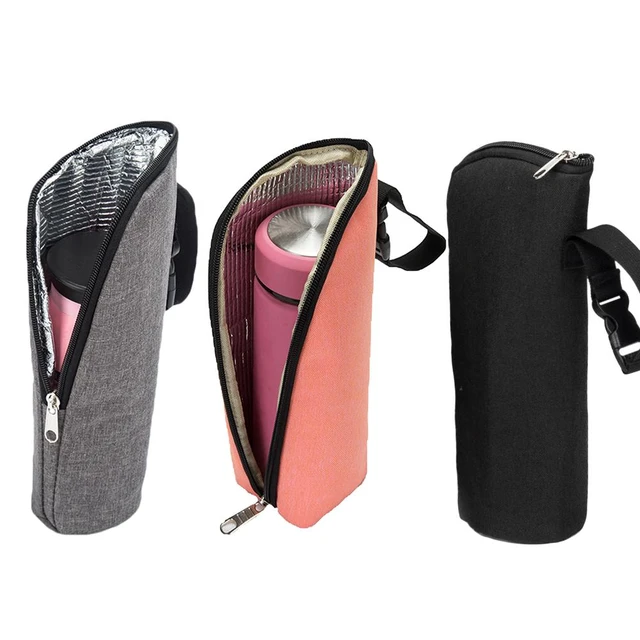 All of their baby food is unsweetened, I love these flavors from this brand:
All of their baby food is unsweetened, I love these flavors from this brand:
- Veggie Bunny: Carrots, Sweet Potatoes, and Peas
- Power Parrot: Pear, Apple, Spinach
- Zebra Beat: Apple, Banana, Beetroot
Cerebelly Organic Custom Pouches: All of Cerebelly’s pouches are super healthy and made with 100% organic ingredients. All of their pouches were developed by their founder – a neuroscientist and mom who is dedicated to creating the highest quality baby food possible. The way it works is super simple: you fill out a quick survey that tells Cerebelly your child’s age and what they’re up to. Cerebelly recommends a personalized pack of organic purees with the right blend of nutrients, and it gets shipped right to your door! The best part – they offer 20% off your first order + free shipping with the code: FIRSTORDER20!
Yumi Organic Baby and Toddler Food. Yumi prides itself on creating custom blends for your baby that are 100% organic, made with real food, customized based on your baby’s stage of eating (from Stage 1 purees all the way to snacks and mini meals!). Their food comes in little jars – not pouches – as it’s made fresh and delivered weekly, straight to your door. You can also be confident that Yumi’s food contains no heavy metals, as they partner with trusted farms that are USDA Certified Organic, Non-GMO Project Verified and follow rigorous food safety testing. They look at federal data on soil contamination to find the best farms. Lastly, you get to choose from their range of 60+ unique organic meals you won’t find anywhere else, handpicked by nutritionists to support every milestone! Yumi is also offering 50% off your first order with the code: PICKY50!
Yumi prides itself on creating custom blends for your baby that are 100% organic, made with real food, customized based on your baby’s stage of eating (from Stage 1 purees all the way to snacks and mini meals!). Their food comes in little jars – not pouches – as it’s made fresh and delivered weekly, straight to your door. You can also be confident that Yumi’s food contains no heavy metals, as they partner with trusted farms that are USDA Certified Organic, Non-GMO Project Verified and follow rigorous food safety testing. They look at federal data on soil contamination to find the best farms. Lastly, you get to choose from their range of 60+ unique organic meals you won’t find anywhere else, handpicked by nutritionists to support every milestone! Yumi is also offering 50% off your first order with the code: PICKY50!
Serenity Kids
I love Serenity Kids because ALL of their pouches are under 5 grams of sugar! They’re 100% organic, made with super clean ingredients, has no added preservatives or sugars, and were created by a husband and wife team trying to find a better option for baby food for their daughter. Here are all of hte pouches I love – use the code PICKY to get 15% off your first order!
Here are all of hte pouches I love – use the code PICKY to get 15% off your first order!
- SK – Kabocha Squash, Butternut, Pumpkin, 2g Sugar
- SK – Butternut Squash + Spinach, 2g Sugar
- SK – Carrot, Spinach and Basil, 3g Sugar
- SK – Chicken, Beef, Pork or Wild Salmon (choose your variety here), 2-3g Sugar
- SK – Carrots, 4g Sugar
- SK – Sweet Potato + Parsnip, 4g Sugar
- SK – Mixed Root Veggies, 4g Sugar
- SK – Sweet Potato + Spinach, 4g Sugar
White Leaf Provisions: WLP is a family business run by a husband and wife team who are bringing the first 100% regeneratively farmed, biodynamic, organic & GMO-Free baby food line to retail in the US! I love their pouches because the ingredients are so pure, and the majority of them have less than 8 grams of sugar per pouch! And, they are offering all of my readers 10% off your purchase by using the code “PICKYEATS” at checkout! My two favorites are:
- WLP – Pumpkin + Nectarine, 5g Sugar
- WLP – Peach + Oat, 7g Sugar
- WLP – Pumpkin + Nectarine, 5g Sugar
- WLP – Peach + Oat, 7g Sugar
Amara Organic – Note: these do not come in a pouch that is ready to serve – they need to be mixed with water or milk and served in a bowl. But these are still a good option if your baby is ok eating from a bowl/spoon and you need an option that saves you time!
But these are still a good option if your baby is ok eating from a bowl/spoon and you need an option that saves you time!
- Amara – Black Bean and Sweet Corn, 0g Sugar
- Amara – Peas, Corn, Carrots, 2g Sugar
- Amara – Potato Kale Mash, 2g Sugar
- Amara – Pumpkin + Pear, 2g Sugar
- Amara – Sweet Potato Raspberry, 5g Sugar
- Amara – Oats and Berries, 5g Sugar
Ella’s Kitchen Organic
- Ella’s Kitchen Veggie Bean Feast, 1g Sugar
- Ella’s Spaghetti and Meatball, 1g Sugar
- Ella’s Beefy Stew, 2g Sugar
- Ella’s Vegetable and Lentil Bake, 3g Sugar
- Ella’s Pears, Peas, and Broccoli, 8g Sugar
Beechnut Organics
- Beechnut Peas & Spinach, 2g Sugar
- Beechnut Peas, Green Bean and Avocado, 4g
- Beechnut Corn, Kale, Quinoa, 4g Sugar
- Beechnut Veggies, Squash, Peas, Pear, 6g Sugar
- Beechnut Apple, Kiwi, Spinach, 6g Sugar
- Beechnut Pear, Pumpkin, Cranberry, 7g Sugar
- Beechnut Veggies, Carrots, Zucchini, Pear, 7g Sugar
- Beechnut Apple, Black Bean, Raspberry, 8g Sugar
Sprout Organic
- Sprout – Green bean, peas, butternut squash, 1g Sugar
- Sprout – Butternut squash, chickpea, quinoa, dates, 4g Sugar
- Sprout – Butternut Squash, Blueberry, Apple, with Beans, 5g Sugar
- Sprout – Mixed Berry Oatmeal, 7g Sugar
Plum Organics
- Plum – Hearty Veggie, Pumpkin, Spinach, Chickpea and Broccoli, 1g Sugar
- Plum – Hearty Veggie, Corn, Kale, Carrot and Tomato, 1g Sugar
- Plum – Hearty Veggie, Butternut Squash, Carrot, Chickpea and Corn, 1g Sugar
- Plum – Hearty Veggie, Carrots, Beans, Spinach and Tomato, 2g Sugar
- Plum – Stage 3 Meals, Carrot, Spinach, Turkey, Corn, Apple, Potato, Celery, Onion, 2g Sugar
- Plum – Stage 3 Meals, Carrot, Chickpea, Pea, Beef, Tomato, Celery, Date, Onion, 4g Sugar
- Plum – Eat Your Colors Red, 5g Sugar
- Plum – Eat Your Colors Orange, 5g Sugar
- Plum – Pear, Green Bean and Greek Yogurt, 6g Sugar
- Plum – Pear Spinach and Pea, 6g Sugar
- Plum – Pear, Purple Carrot and Blueberry, 7g Sugar
- Plum – Eat Your Colors Green, 7g Sugar
- Plum – Mighty 4 – Guava, Banana, Black Bean, Carrot, Oat, 7g Sugar
- Plum – Mighty 4 – Pear, Cherry, Blackberry, Strawberry, Spinach, 7g Sugar
Happy Family Organics
- HF – Hearty Meals, Root Vegetables, Turkey and Quinoa, 2g Sugar
- HF – Hearty Meals, Harvest Vegetables, Chicken and Quinoa, 2g Sugar
- HF – Hearty Meals, Vegetable Beef Medley, 3g Sugar
- HF – Green Beans, Spinach, and Pears, 4g Sugar
- HF – Zucchini, Pear, Chickpea, Kale 5g Sugar
- HF – Purple Carrots, Banana, Avocado, and Quinoa, 6g Sugar
- HF – Zucchini, Apples, Peas, Quinoa, and Basil, 6g Sugar
- HF – Pear, Green Beans, Peas + Super Chia, 6g Sugar
- HF – Pears, Kale, and Spinach, 7g Sugar
- HF – Black Beans, Beets and Bananas, 7g Sugar
- HF – Pears, Pumpkin, Peaches, and Granola, 7g Sugar
- HF – Pears, Peas, Broccoli, 7g Sugar in the new formulation
- HF – Pumpkin, Apples, Peached and Cinnamon, 8g
- HF – Pears, Squash, and Blackberries, 8g Sugar
- HF – Pears, Zucchini, Peas, 8g Sugar
- HF – Pears, Pumpkin, Passionfruit, 8g Sugar
Earth’s Best
- EB – Broccoli, Red Lentil, Oat, 1g Sugar
- EB – Spinach & Potato, 1g Sugar
- EB – Carrots & Broccoli, 2g Sugar
- EB – Winter Squash, 2g Sugar
- EB – Summer Vegetable Dinner, 2g Sugar
- EB – Corn & Butternut Squash, 3g Sugar
- EB – Peas & Brown Rice, 4g Sugar
- EB – Zucchini & Broccoli Medley, 4g Sugar
- EB – Spring Vegetables & Pasta, 4g Sugar
Note: If you are in Canada, Baby Gourmet has a couple of good options (e.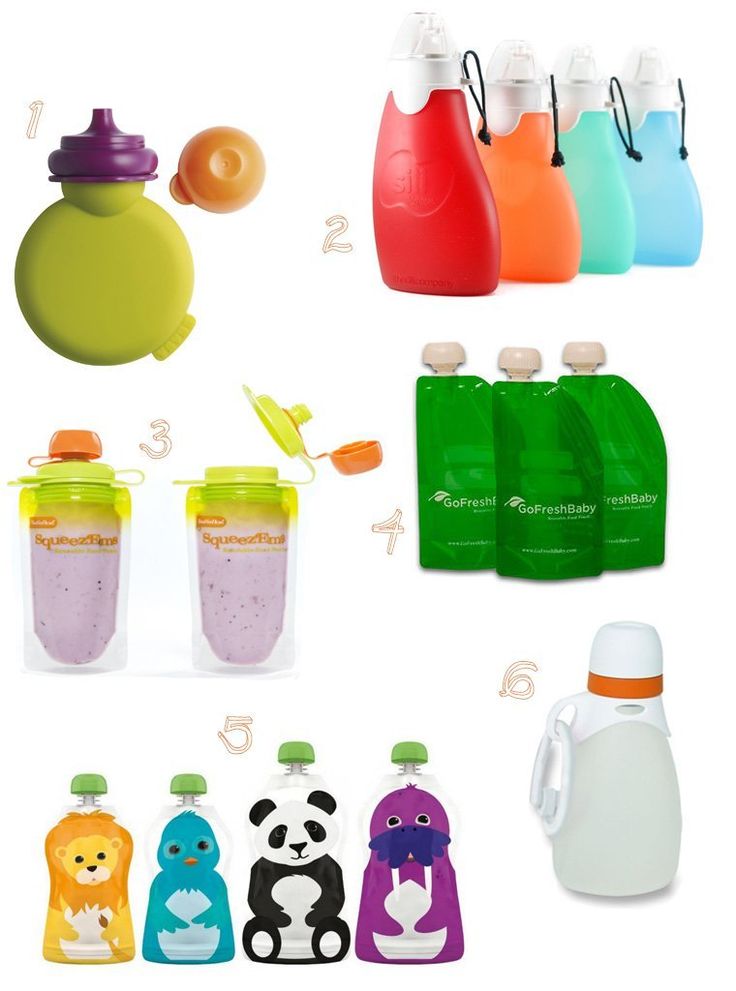 g. their roasted squash and fruit medley has only 6 grams of sugar!), and their savory meals are low in sugar as well!
g. their roasted squash and fruit medley has only 6 grams of sugar!), and their savory meals are low in sugar as well!
I used many of the pouches on this list (prioritizing the flavors listed in bold since those contain only veggies) for my kids when I needed a meal on the go. One thing to note on these pouches is that even if you use them regularly, it’s still important to incorporate a variety of finger foods so your baby becomes familiar with the different textures and flavors of non-pureed food.
I know the baby food aisle can be overwhelming at times, but I hope this post helps you find the healthiest baby food pouches with confidence! If you have any questions, don’t hesitate to leave me a comment on this post or contact me here! I respond to every single message I get! 🙂
For more information about the best products for baby, check out these posts!
- The Best Probiotics for Kids
- Best Baby Cereal Brands
- 80+ Healthy Road Trip Snacks For Kids And Toddlers
- Best Organic Baby Formula
- Healthiest Children’s Multivitamins (see my top pick here)
Why mothers choose frameless furniture
Caring mothers always choose the best for their babies: in clothes, food and furniture.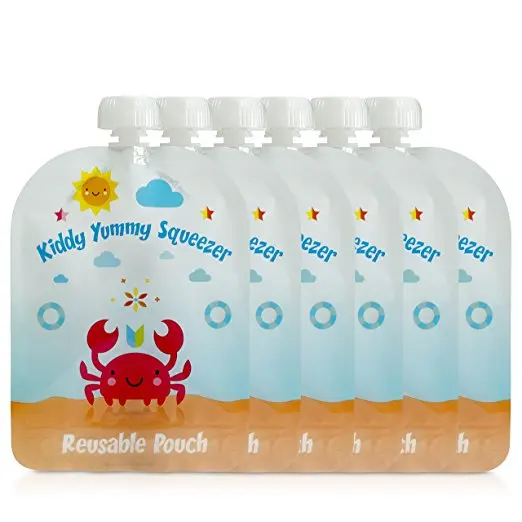 We are very glad that mothers like our pear chairs and often appear in houses where children live!
We are very glad that mothers like our pear chairs and often appear in houses where children live!
Bean bag, having appeared in a child at a young age, can serve him for a long time and go through all stages of development with the baby. Thus, frameless furniture will live next to children for several years and will become a favorite thing in the house. On it, the child will be able to make the first discoveries, exploring the space when he is only a year old. And then with pleasure to watch cartoons, read books at an older age.
Why else do moms buy frameless furniture? Consider the reasons:
1. Furniture is safe.
Frameless furniture is called so because it does not contain a rigid frame. Therefore, it does not pose a danger to children: they will not hit hard parts, they will not be able to fall off the seat of the bag or drop it on themselves, as sometimes happens with chairs. There are also no sharp corners on frameless furniture, which is important at any age. And the absence of small details allows the use of frameless furniture from a very young age.
And the absence of small details allows the use of frameless furniture from a very young age.
2. Suitable for feeding.
Frameless furniture helps to relax muscles, take a comfortable posture while sitting, comfortably position your back, neck and head. Therefore, it is the ideal furniture for breastfeeding babies. A young mother will be able to sit perfectly on the armchair and feed the baby without experiencing any inconvenience.
3. Easy to care for.
All mothers know how difficult it is to keep things clean in a child's room. But caring for frameless furniture will not give you trouble! All furniture on the site superpuff.ru has an external cover that can be easily removed. The outer cover can be easily machine washed with ordinary powder and dried at home. It can be washed several times a month as it gets dirty and put on the chair again. Thus, in the room the kids will always have comfortable clean furniture.
4.
 Provides comfort.
Provides comfort. Frameless furniture designed to provide people with comfort while relaxing. Soft fabric, modern ottoman filler, frameless base make this type of furniture ideal for relaxation. Sitting on a beanbag chair or on a cushion chair, the child will be able to relax between games, take a break between classes and recuperate.
5. She decorates the interior.
Frameless furniture always looks very stylish and original. Therefore, it is invariably the highlight of any interior. Moms who are attentive to the arrangement of the children's room often choose bag chairs, floor cushions or knitted poufs. Our site presents a huge number of different colors of furniture, which allows you to choose the perfect option for every child's room!
6. Easy to carry from place to place.
Frameless furniture, be it a pear chair or a triangular chair, weighs very little. This means that it can be easily moved from place to place. Therefore, families like to use such furniture. Children can easily take chairs to their games and carry them wherever they want. And parents will be able to read fairy tales to their children in the evenings in the armchair, and then take it with them to the living room and watch movies or read magazines on it.
Children can easily take chairs to their games and carry them wherever they want. And parents will be able to read fairy tales to their children in the evenings in the armchair, and then take it with them to the living room and watch movies or read magazines on it.
Knitted round pouffe is also very light and can be carried from place to place even by a child.
7. Oksford pouffes can be used outdoors.
We have a range of furniture made from Oksford fabric on our website. This material is specially designed for outdoor use. Therefore, he is not afraid of splashing water, stains from grass, earth, berries. Things made of Oksford fabric can be safely taken out to the balcony, to the terrace, to the backyard. And this furniture is ideal for use by kids. After all, all stains from paints, food, juices are easily removed from it with a damp cloth. Many mothers appreciate this quality and choose Oksford chairs for their home.
8. Frameless furniture develops imagination.
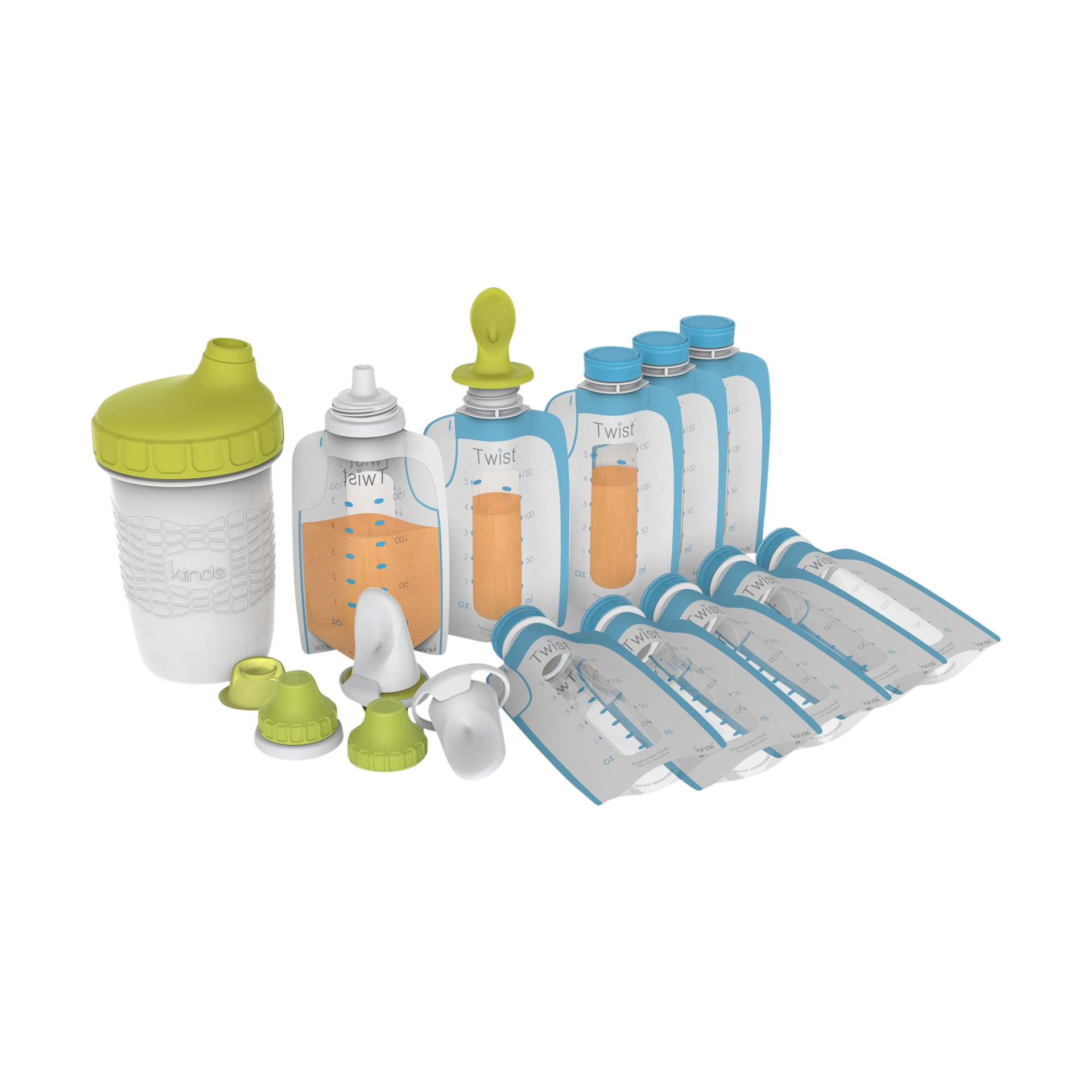
Frameless furniture is perfect not only for relaxing, but also for playing. Children instantly come up with many games with a bean bag, make it a mountain, a castle and various wonderful things. The chair can be placed, laid horizontally, twirled, as you like, and create from it what the children want!
Here are just a few of the reasons caring moms choose frameless furniture.
Always yours,
SUPERPUFF Mom course (preparation courses for pregnancy, childbirth and motherhood)
Baby chair for mom, an overview of the options found
Manufacturers today create many unique pieces of furniture that make people's lives comfortable and easy. Let's talk further about what features a baby feeding chair has for mom, because such interior items have recently been in incredible demand around the world.
9OloTypes of chairs for feeding a child for mothers
The armchair from modern manufacturers is divided into several types according to certain characteristics.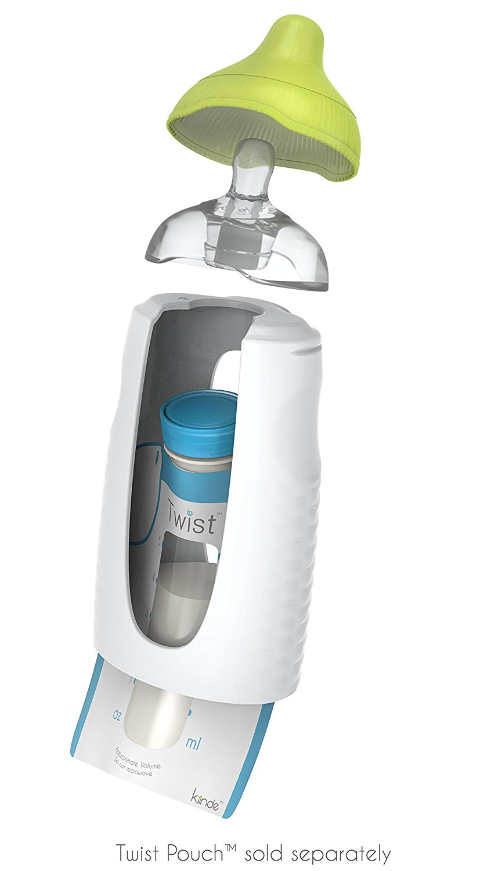 In order not to make a mistake in choosing, it is important to distinguish the features of each of them.
In order not to make a mistake in choosing, it is important to distinguish the features of each of them.
Based on the manufacturing design features, you can choose:
- stationary chair with legs for feeding, with a spring mechanism. The swaying effect in this case is achieved due to the pressure of the mother's weight on the sitting surface;
- models with a rotating mechanism that can rotate the seating surface in a circle;
- rocking chair used for feeding a baby for mom with arched skids. When swinging under the weight of a seated person, it makes translational movements back and forth;
- gliders with a pendulum mechanism, swaying due to the weight of a seated person. Able to withstand a fairly significant load, very comfortable to use.
Based on the material of manufacture, there are:
- rattan - very original in appearance, safe for the health of mother and baby, do not contain harmful components.
 The rocking effect is achieved due to the presence of either a spring mechanism or arcuate skids in such chairs. Rattan demonstrates high practicality, does not require careful maintenance, is durable and resistant to wear;
The rocking effect is achieved due to the presence of either a spring mechanism or arcuate skids in such chairs. Rattan demonstrates high practicality, does not require careful maintenance, is durable and resistant to wear; - wicker products for feeding the baby are made from natural wicker, so they are completely safe. However, wicker models do not have anatomical backs, therefore they are less convenient than other options. Relaxation of the mother's musculoskeletal system when sitting on such a chair is achieved by rocking. Note that wicker furniture is afraid of a long stay in the open sun;
- metal chairs for feeding a child with a soft seat, back and armrests, sheathed in textiles, leather or leatherette;
- wooden models are natural in composition, safe, non-toxic, durable, so models from this material are approved by many positive reviews from satisfied customers.
Based on the ability to fold the structure, the following models are found.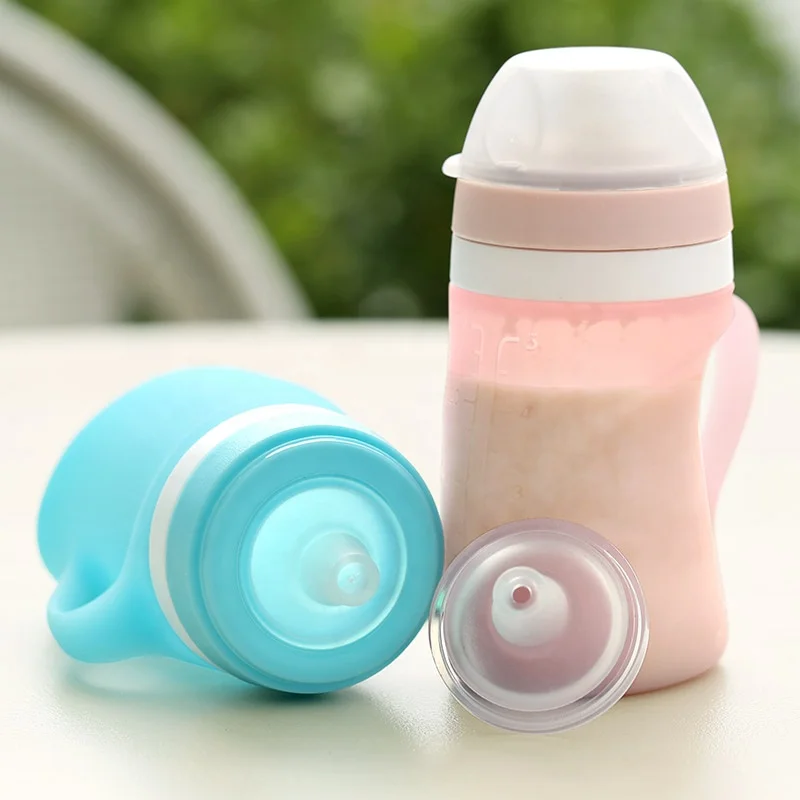
| Rocking chair view | Features |
| Anatomical folding chairs | Suitable for mobile people who are accustomed to surround themselves with comfort everywhere (at their summer cottage, at home, at a party, and so on) |
| Structures without the possibility of transformation or folding | May cost less than folding models but take up more space |
Highlights
The furniture frame, on which the parent who feeds their baby can comfortably lean, is made of solid materials. The model always has armrests, and some also have a comfortable footrest.
Many models allow you to change the angle of the backrest, which makes the process of feeding and rocking the baby more comfortable.
The back of the maternity chair is always high and can be anatomically shaped. In any case, the back, neck and head of the person sitting on such furniture is provided with reliable support.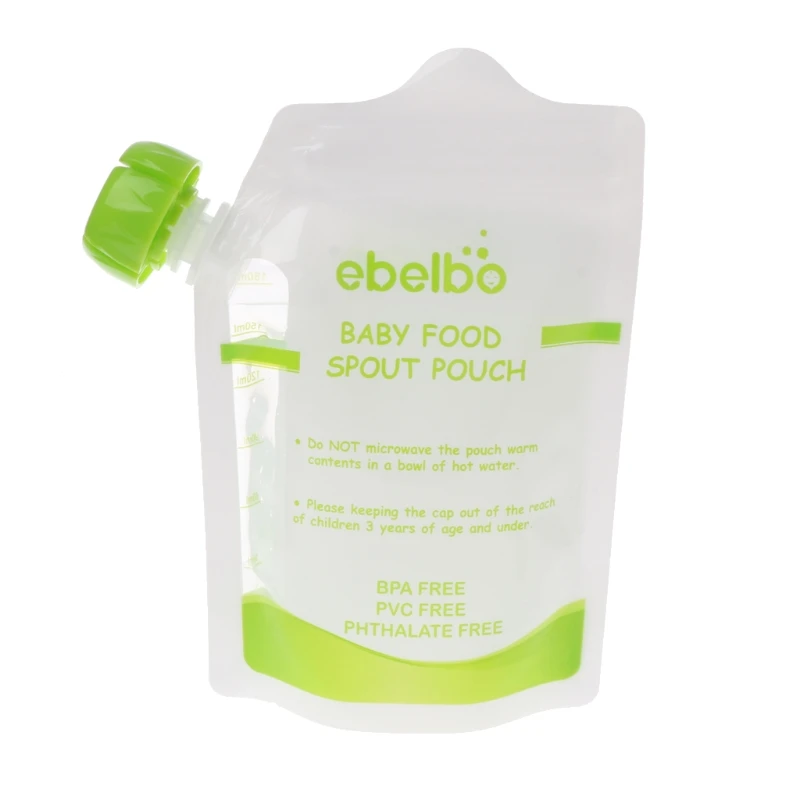 The longer the runners of the chair, the greater the amplitude when swinging it will demonstrate. Although many users note in their reviews the fact that it is easier to get up from models with short skids, as they are more stable.
The longer the runners of the chair, the greater the amplitude when swinging it will demonstrate. Although many users note in their reviews the fact that it is easier to get up from models with short skids, as they are more stable.
Nuances of choice
A child seat must necessarily have high performance parameters, so it is important to consider many factors when choosing it:
- The materials used in the manufacturing process must be safe, practical and durable. The composition of the structural elements of the seats should not contain radioactive components, toxic substances, materials with a pungent odor. Regarding reliability, it is better to give preference to metal, wooden frames, as well as rattan models. And the upholstery material and filler for the seat, backrest and armrests is better to choose a breathable, environmentally friendly. The padding is made from eco-friendly fabrics. This is extremely important for the health of the baby and his mother, so that they do not provoke the development of allergic reactions and other similar complications;
- model build quality will directly determine the safety of the product and its durability.
 Be sure to check if the seller of the model has all the necessary documents (quality certificate, passport, and so on). The chair itself must be visually examined for defects or unreliable fasteners;
Be sure to check if the seller of the model has all the necessary documents (quality certificate, passport, and so on). The chair itself must be visually examined for defects or unreliable fasteners; - allowable weight load. Choose chairs with a good weight margin, then it will last a longer period;
- dimensions of the chair - in terms of dimensions, the product must fit the user in height, then the mother's back will be provided with the most reliable support;
- level of functionality and comfort - the most practical and easy-to-use chairs for moms with the ability to adjust the height and angle of the backrest, armrests and footrest. The most comfortable, as practice shows, are those chairs that have a long back;
- chair care features are also important to consider when choosing it. It is good if the selected model will have a removable cover that can be washed in a washing machine if necessary. But cheap leatherette should be abandoned, as it quickly scratches and becomes unusable;
- rocking mechanism - it is better to test the model by sitting in it for a few minutes.
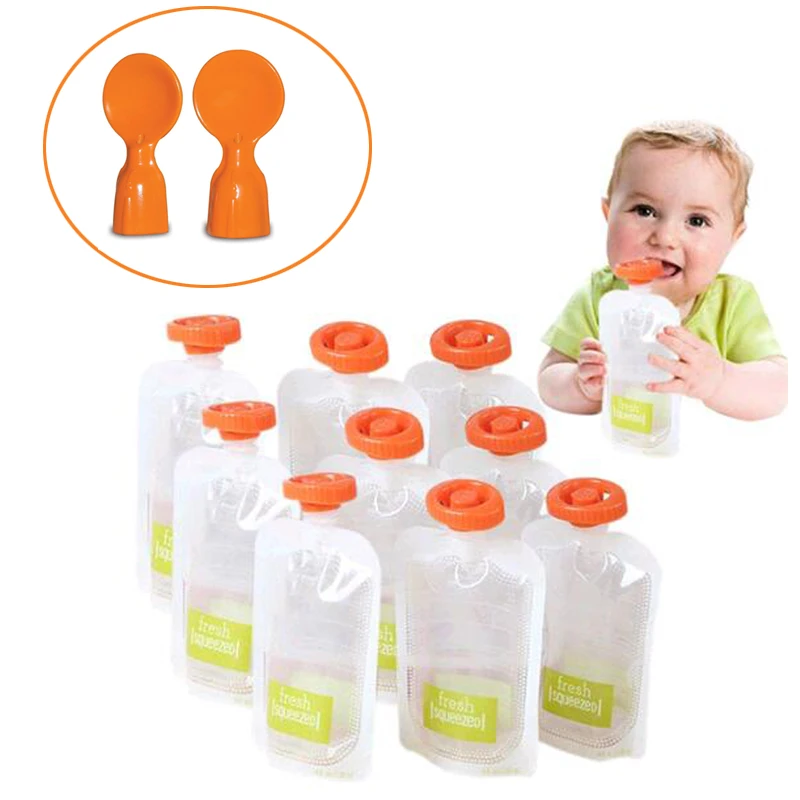 Is it convenient for you to get up from the chair, does it sway smoothly;
Is it convenient for you to get up from the chair, does it sway smoothly; - the cost of good furniture for feeding a baby for a mother cannot be very cheap, which is important to remember when choosing it. If the seller offers surprisingly good prices, it is worth paying double attention to the analysis of the proposed model.
Usage Precautions
There are a few other things to consider when choosing a mummy chair. First of all, do not forget to check the reliability of the fasteners and connections of the product. It is better to order the assembly of the model at home from a qualified specialist, because not everyone can independently assemble a complex structure in the right way. Savings on professional assembler fees can reduce the safety of the product.
Experts do not recommend the use of such furniture as a stand or stairs. It is strictly forbidden to stand on it with your feet.
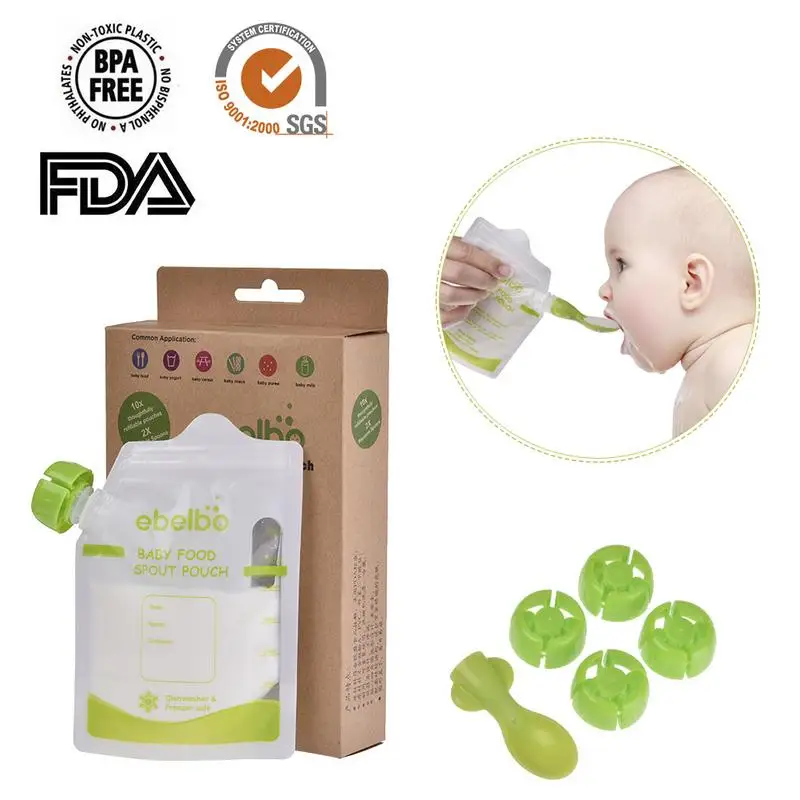
It is also worth avoiding excessive rocking on the rocking chair for mother and child. It is not necessary to overload the model, make sure that the level of load on the furniture complies with the manufacturer's recommendations.
Care instructions
Such chairs should be used only for the purpose of feeding, rocking the baby, as well as resting his mother. Regularly wipe it from dust and dirt with a damp cloth of a soft nature. In case of greasy stains, you can use a soapy solution, and then wipe the surface of the furniture dry.
Long-term contact of such items with water should not be allowed if they are made of wicker or metal. Also, the vine should not be left in the sun for a long time, otherwise it may dry out. Do not use aggressive detergents to care for such interior items.
Video
Rocking chairs for nursing mothers.
Photo of a chair for feeding a child by a mother
Variants of chairs for mothers with small children.